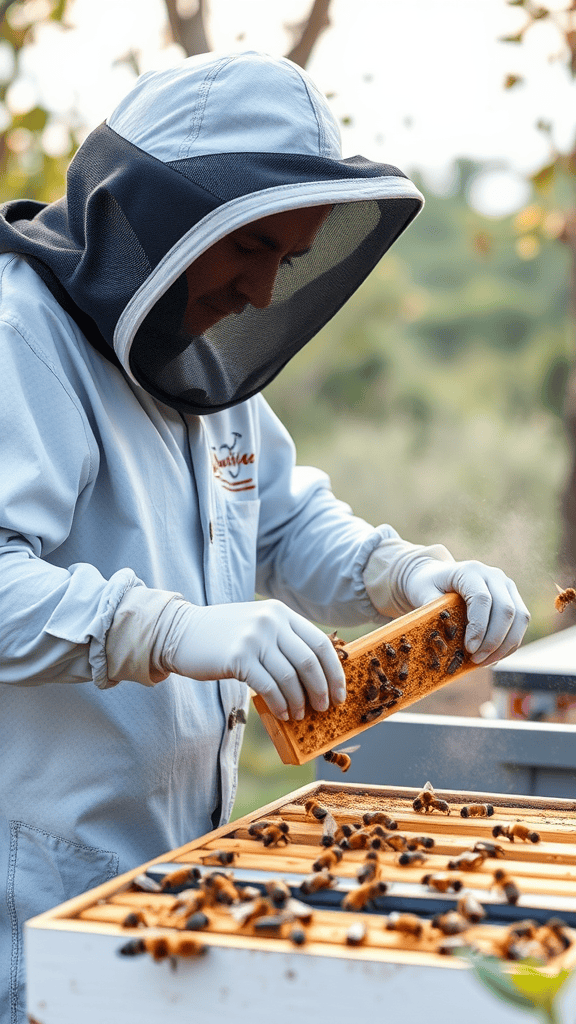Exploring the Benefits of Top Bar Beekeeping for Sustainable Honey Production
For many people, beekeeping is a rewarding pursuit that offers not only honey but also a connection to nature. In recent years, top bar beekeeping has gained popularity as a sustainable method for honey production. This technique focuses on the well-being of bees and the environment, making it an attractive option for those who wish to produce honey in a more humane and eco-friendly manner.
Understanding Top Bar Beekeeping
Top bar beekeeping involves using a box-like hive that has horizontal bars across the top. Bees build their comb downward from these bars. Unlike traditional hives, which use vertical frames, top bar hives offer a more natural environment for bees. This design not only respects their behavior but also makes honey harvesting easier and more intuitive.
Benefits of Top Bar Beekeeping
Many beekeepers are turning to this method for a variety of reasons. Here are some of the key benefits:
- Respect for Bee Behavior: Top bar hives allow bees to build their comb freely, closer to their natural instincts. This promotes healthier colonies.
- Easier Honey Harvesting: Harvesting honey is more straightforward in a top bar hive. You can cut the comb directly from the bars without disrupting the entire colony.
- Cost Efficiency: Creating a top bar hive can be less expensive than traditional hive setups. You can even build your own using simple materials, making it a more accessible option for many.
- Less Maintenance: The natural structure of a top bar hive can lead to fewer management interventions. This allows beekeepers to enjoy their hobby with minimal stress.
- Better Pest Management: With the open design, it’s easier to monitor your bees. You can spot issues like pests or diseases early, often leading to less intervention overall.
Sustainability in Honey Production
When considering sustainable practices in honey production, top bar beekeeping shines brightly. It encourages beekeepers to prioritize seasonal cycles and local flora, which enhances the ecosystem.
Using top bar hives, you can also promote biodiversity. You’re more likely to engage local plants, as the bees will forage from their immediate environment. This not only helps your bees thrive but also supports nearby wildlife. By favoring native plants, you encourage local flora and fauna to flourish, which contributes to ecological balance.
Beekeeping Community and Education
Participating in top bar beekeeping can also connect you with a vibrant community of like-minded individuals. Many local groups and online forums share tips, experiences, and resources tailored to this method. Engaging with others can enhance your understanding and ability to manage your hives.
Furthermore, learning about top bar beekeeping often involves educational outreach, where seasoned beekeepers pass on their knowledge. This support network can help beginners quickly navigate challenges while promoting safe and sustainable practices.
Considerations for New Beekeepers
If you’re considering entering the world of beekeeping, here are some essential tips:
- Start small: Focus on one or two hives to learn the ropes before expanding.
- Research: Read books or articles specifically about top bar beekeeping to build a solid foundation.
- Connect: Join local beekeeping clubs to gain insights from experienced beekeepers.
- Be patient: Understand that beekeeping is a journey. You’ll learn as you go.
Top bar beekeeping offers a unique and sustainable approach to honey production. It provides multiple benefits that align with nurturing bees and protecting the environment. As a beekeeper, you can experience a fulfilling connection with nature while contributing to the sustainability of our planet. Embracing this method allows you to join a community dedicated to promoting a healthier ecosystem, resulting in not just honey, but a thriving environment for all living creatures.
Essential Equipment and Best Practices for Successful Top Bar Beekeeping
Top bar beekeeping is an increasingly popular method for keeping bees due to its simplicity and the natural approach it offers. To embark on this rewarding journey, it is important to understand the essential equipment and adopt best practices that can ensure your success as a beekeeper. Here’s a guide to get you started effectively.
First and foremost, the most vital piece of equipment is the top bar hive itself. These hives are designed to allow bees to build their own comb without the foundation usually found in traditional frames. The bars are long and flat, laying horizontally across the hive, which allows bees to create combs of varying sizes depending on their needs. Ensure the hive is constructed correctly, with adequate ventilation and protection from predators.
Aside from the hive, you will need several additional tools to make your beekeeping journey smoother:
- Bee Suit: Protecting yourself from bee stings is paramount. A well-fitted bee suit along with gloves will keep you safe while allowing for the needed access to your bees.
- Hive Tool: This is a must-have for prying open the hive and separating the bars. A hive tool helps maintain the structure of the hive and check the health of the colony.
- Smoker: Bees can be defensive when disturbed. A smoker calms them down by masking alarm pheromones, making inspections safer and easier.
- Bee Brush: This gentle brush will help you clear bees off the bars when you need to inspect or harvest honey without harming them.
- Jars and Containers: If you plan to harvest honey, having appropriate jars and containers is essential for storing your honey safely and cleanly.
An essential practice when keeping bees is routine inspections. You should inspect your hive regularly, generally every week or two during the peak season. During these inspections, look for signs of health within the colony, such as an active queen, brood patterns, and the overall behavior of the bees. If you notice any issues, you can address them before they escalate into more serious problems.
Another crucial practice is maintaining the proper bee population. Top bar hives allow bees to swarm more naturally, which is advantageous. However, it is important to monitor the population and intervene if necessary. Trimming back bars or adding more bars can help manage the hive’s growth effectively. Splitting the hives can also be a useful strategy if a colony becomes too large.
Feeding your bees is often necessary, especially during the initial months after a hive is established or when the nectar flow is low. Using sugar syrup or pollen patties can help support their growth. However, it’s vital to be cautious and avoid overfeeding, which can lead to other complications such as robbing.
Selecting the right bee breed is another aspect that can play a significant role in your success in top bar beekeeping. Some breeds are easier to manage and are more suited to the top bar style. For instance, the Carniolan and Italian bees are known for their docility and productivity, making them a fantastic choice for beginners.
Ensure that you maintain cleanliness within and around your hive. Regularly remove debris and dead bees, and ensure that the area around your hives is tidy. This helps prevent pests and diseases from taking hold in your hives.
Getting involved with local beekeeping communities or forums can also enhance your learning and experience. These networks can provide valuable insights, practical advice, and support from fellow beekeepers. Engaging with others allows you to share your experiences, troubleshoot problems, and celebrate achievements together.
Success in top bar beekeeping hinges on understanding the essential equipment and adopting best management practices. With the right tools, regular inspections, appropriate feeding, and careful monitoring, you can create a thriving environment for your bees. Happy beekeeping!
Conclusion
Top Bar Beekeeping presents an innovative and sustainable approach to honey production that appeals to both novice and experienced beekeepers alike. By embracing this method, you gain not only the satisfaction of creating your own honey but also contribute positively to the environment. Its emphasis on natural beekeeping practices encourages higher bee health and lower stress levels for the colonies, reflecting a commitment to sustainability that benefits both the bees and the ecosystem.
Equipping yourself with the right tools and knowledge is key to thriving in top bar beekeeping. Investing in quality materials such as top bar hives, which are designed to facilitate better bee behavior and enhance honey collection, is essential. Additionally, following best practices such as regular inspections, emphasizing bee comfort, and employing organic methods for pest management will set you on the path to success.
Whether you are looking to cultivate a small backyard hive or dive into more extensive production, top bar beekeeping can be a rewarding venture. The joy of harvesting your own honey along with the satisfaction of fostering a thriving bee community is truly unparalleled. With patience and dedication, you can enjoy the sweet rewards of your efforts while supporting sustainable practices that enrich the environment. As you embark on this journey, remember that each step you take in top bar beekeeping not only nourishes your passion but also plays a vital role in supporting the precious pollinators that our planet needs.
As an Amazon Associate, I earn from qualifying purchases.

